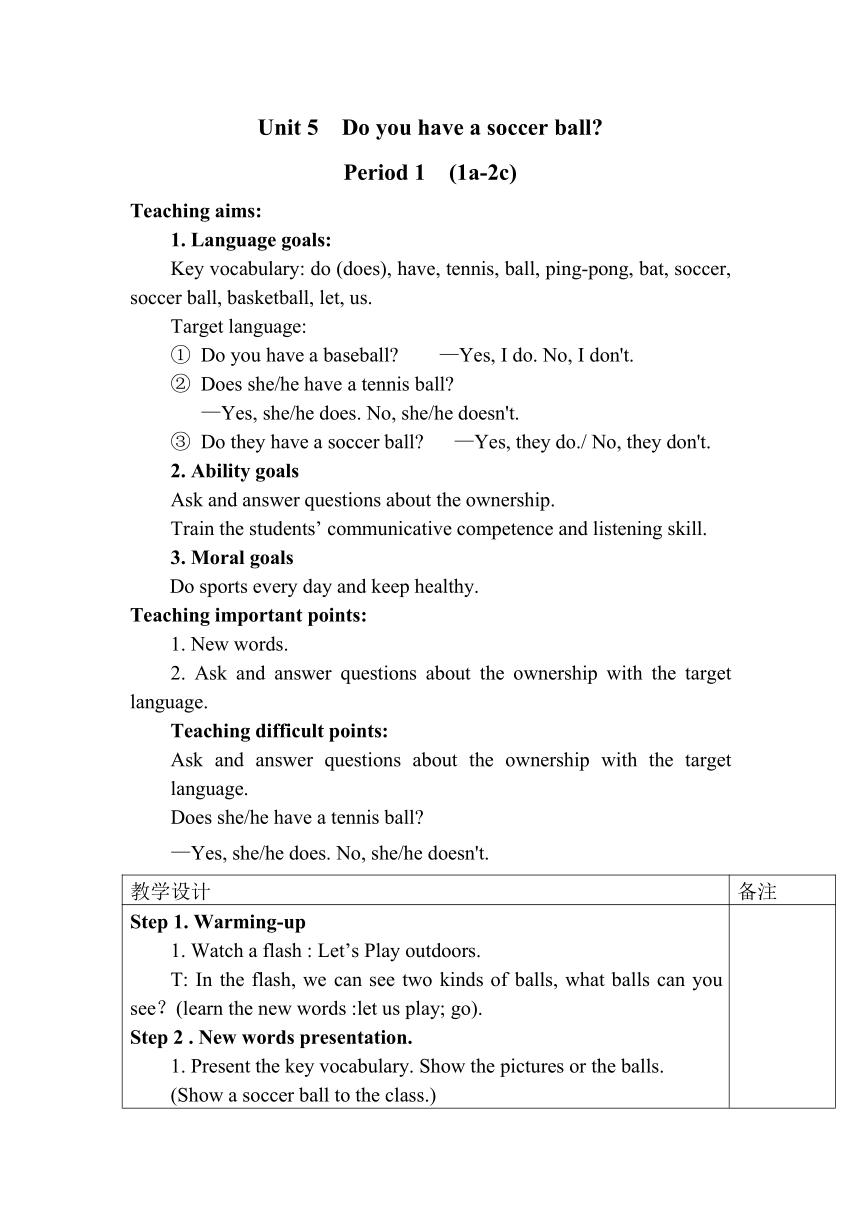
Unit 5 Do you have a soccer ball? Period 1 (1a-2c) Teaching aims: 1. Language goals: Key vocabulary: do (does), have, tennis, ball, ping-pong, bat, soccer, soccer ball, basketball, let, us. Target language: ① Do you have a baseball? —Yes, I do. No, I don't. ② Does she/he have a tennis ball? —Yes, she/he does. No, she/he doesn't. ③ Do they have a soccer ball? —Yes, they do./ No, they don't. 2. Ability goals Ask and answer questions about the ownership. Train the students’ communicative competence and listening skill. 3. Moral goals Do sports every day and keep healthy. Teaching important points: 1. New words. 2. Ask and answer questions about the ownership with the target language. Teaching difficult points: Ask and answer questions about the ownership with the target language. Does she/he have a tennis ball? —Yes, she/he does. No, she/he doesn't. 教学设计 备注 Step 1. Warming-up 1. Watch a flash : Let’s Play outdoors. T: In the flash, we can see two kinds of balls, what balls can you see?(learn the new words :let us play; go). Step 2 . New words presentation. 1. Present the key vocabulary. Show the pictures or the balls. (Show a soccer ball to the class.) T: What’s this in English? S1: It’s a soccer ball. T: Yes, you are right. Read after me. Then say: Let’s play soccer.—play soccer. (Show the students other objects or pictures. Teach the new words “basketball, ping-pong ball, volleyball, tennis bat, ping-pong bat” in the same way.) T: Read the words together twice. 2. Try to remember the words by reading. 3. Play a game: Who has best eyes. Step 3 Work on 1a 1. T: What can you see in the picture??And ask?“Where?is?the..? 2. Look at the words in 1a and match the words with the things in the picture. T: Number 1 is (a), tennis ball. What’s Number 2 Match them. 3. Ask one student to show the answers and check them. Step 4 Present the key structure 1 . 1. Present these questions and answers. (Point to a student who has a pencil box.) T: Do you have a pencil box? S1: Yes, I do. (Nod your head yes) T: Do you have a basketball? S1: Yes, I do. I have a basketball. T: Do you have a ping-pong bat ? S1: No, I don’t. I don’t have a ping-pong bat. 2. Write the sentences on the blackboard. Practice the drill “Do you have a …?” in pairs. Look at the model, then practice like this. Model: S1: Do you have a basketball? S2: Yes, I do. I have a basketball. S1: Do you have a soccer ball? S1: No, I don’t. I don’t have a soccer ball. (Students work in pairs.) Step 5 . Work on 1b :Listening T: Look at the four items of 1b in the pictures. Listen to the conversation. T: Listen to the conversation and circle the words you hear. (Play the recording.) T: Check their answers. Step 6. 1c Pair work 1. Read the conversations in 1c. (Ask students to repeat.) 2. Watch a video. 3. Look at the picture in 1a and practice the conversation with each other in pairs. S1: Do you have …? S2: Yes, I do. S1: Do you have a …? S2: No, I don’t. Step 7 Present the k ... ...
~~ 您好,已阅读到文档的结尾了 ~~

